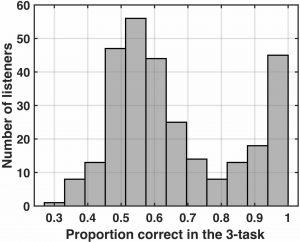Theories of music composition suggest that variations in scale are central to music’s emotional meaning. For example, many studies have shown that, on average, music in the major scale tends to sound “happy” whereas music in the minor scale tends to sound “sad.” As we have discovered, however, a majority of listeners (around 70%) have little or no sensitivity to the qualities that music can achieve through scale variations while the remaining 30% of listeners are highly sensitive to these qualities (Chubb et al., 2013, Dean & Chubb, 2017, Mednicoff et al., 2018, Ho & Chubb, 2020). We discovered this by testing listeners in the following task, called the 3-task (because major and minor stimuli in this task differ in degree 3 of the major and minor scales). On each trial, the listener hears a rapid, random sequence of 32 pure tones. All of these “tone-scrambles” contain 8 each of the notes G5 (the fifth G from the left on the piano keyboard), D6 and G6. These 24 notes serve to establish G as the tonic center of every stimulus. In addition, major tone-scrambles contain 8 copies of the note B5 (the third note of the G major scale) whereas minor tone-scrambles contain 8 copies of the note Bb5 (the third note of the G minor scale). The listener’s task is to classify the tone-scramble presented on each trial as either major (happy-sounding) or minor (sad-sounding). The figure below shows the distribution of proportion correct in this task.
As this figure shows, most people (around 70% of all listeners) perform near chance in the 3-task; the other 30% of listeners perform near ceiling.
It seems as though the sensitivity required for the 3-task is either hereditary or else formed very early in life. First, skill in the 3-task does not depend on musical training: We find listeners with many years of musical training who perform near chance in the 3-task and other listeners with little or no training who perform near ceiling. We have also found that 6-month-old infants show the same bimodal distribution in sensitivity as adults (Adler et al., 2020).
If you would like to try the 3-task yourself, click on this link (your data will not be saved): Try out the 3-task
You might also like to try the some related games at The Music Lab. The particular game (which takes around 5 minutes) that includes a short (and exciting) version of the 3-task as well as several other tone-scramble tasks is called “Are You a Super-Listener?” Over 50,000 listeners around the world have played this game.
References:
- Ho, Mann, Hickok & Chubb (in press, 2022)
- Adler, Comishen, Wong-Kee-You & Chubb (2020)
- Ho & Chubb (2020)
- Mednicoff, Mejia, Rashid & Chubb (2018)
- Dean & Chubb (2017)
- Chubb, Dickson, Dean, Fagan, Mann, Wright, Silva, Guan, Gregersen & Kowalsky (2013)
